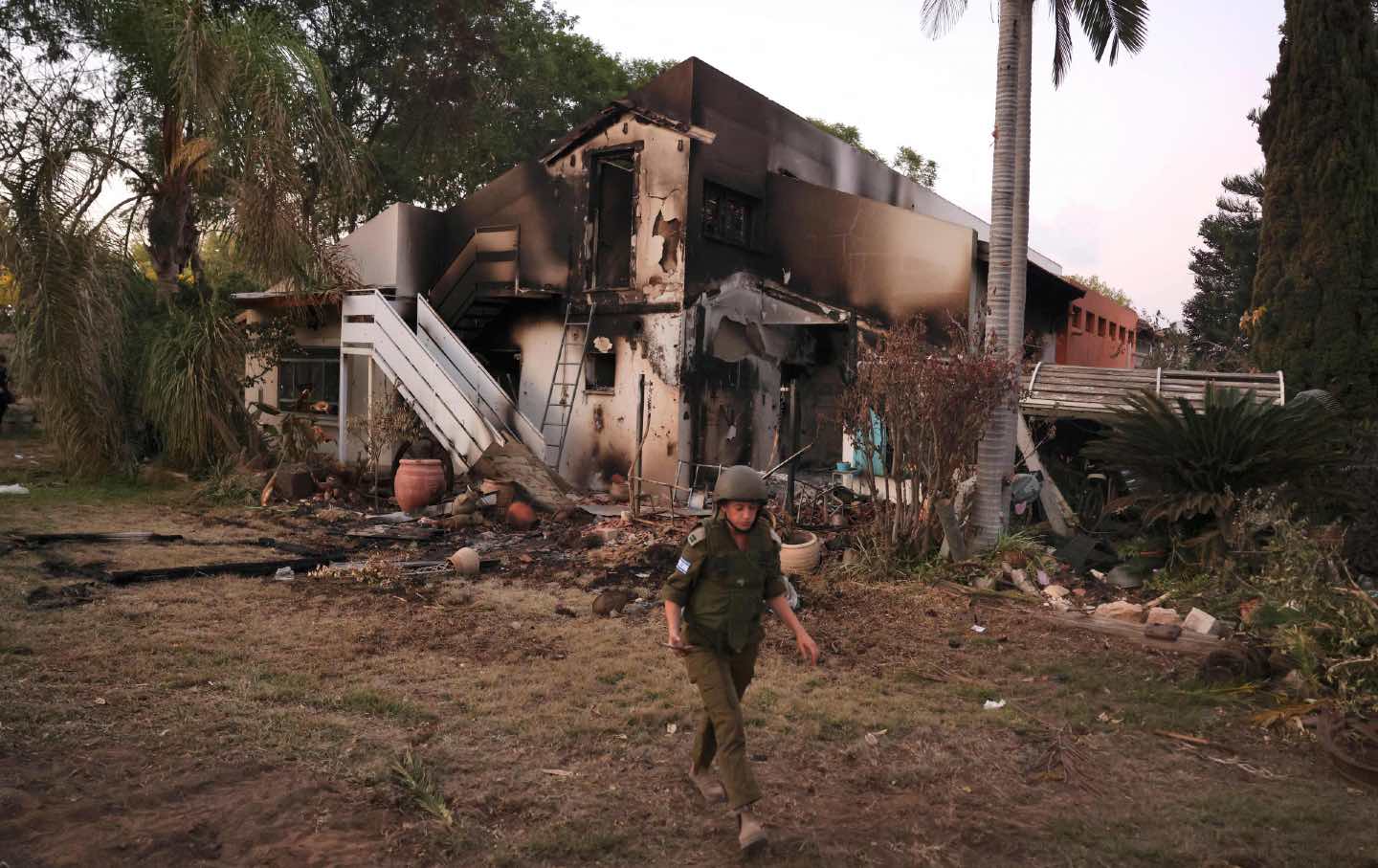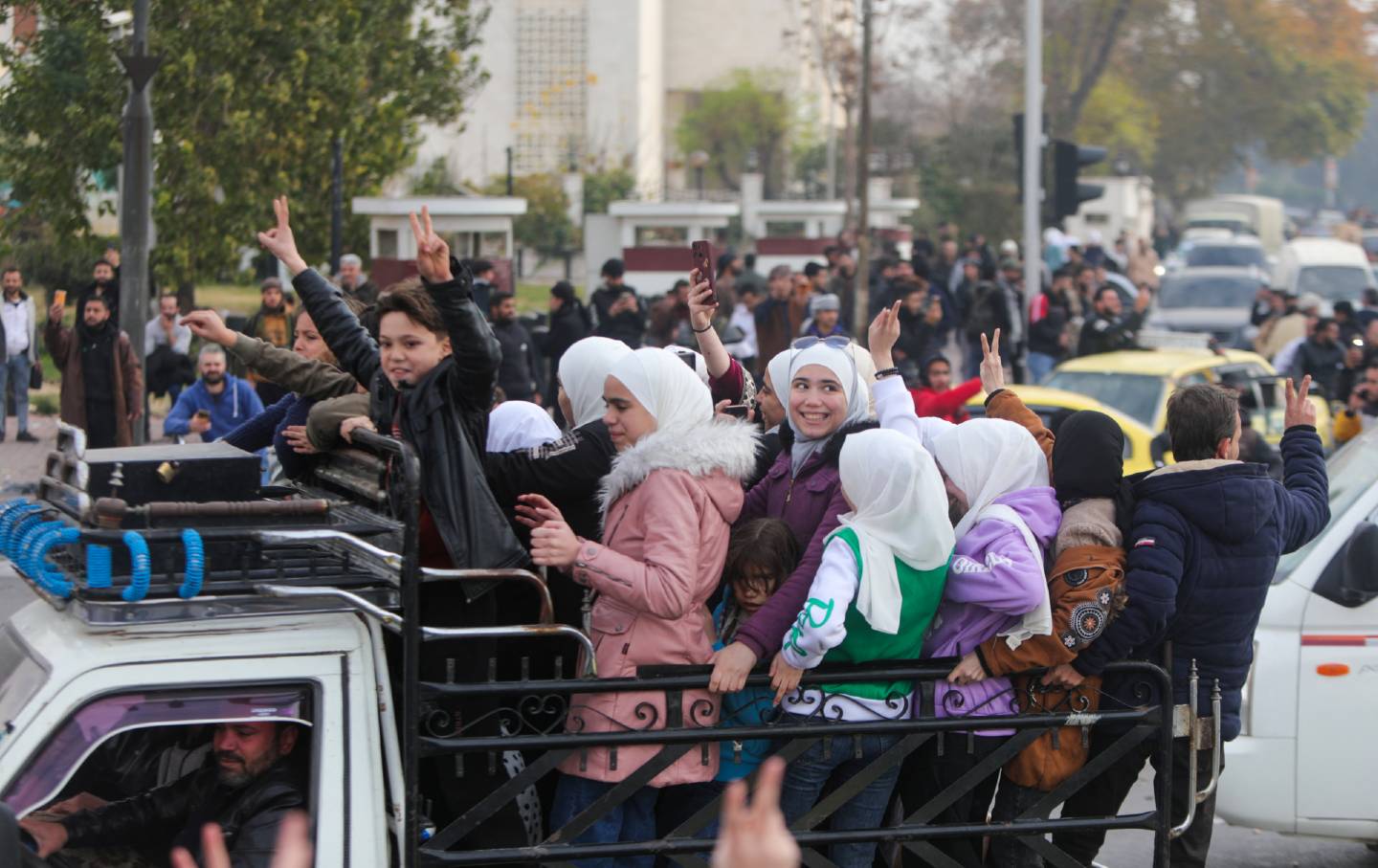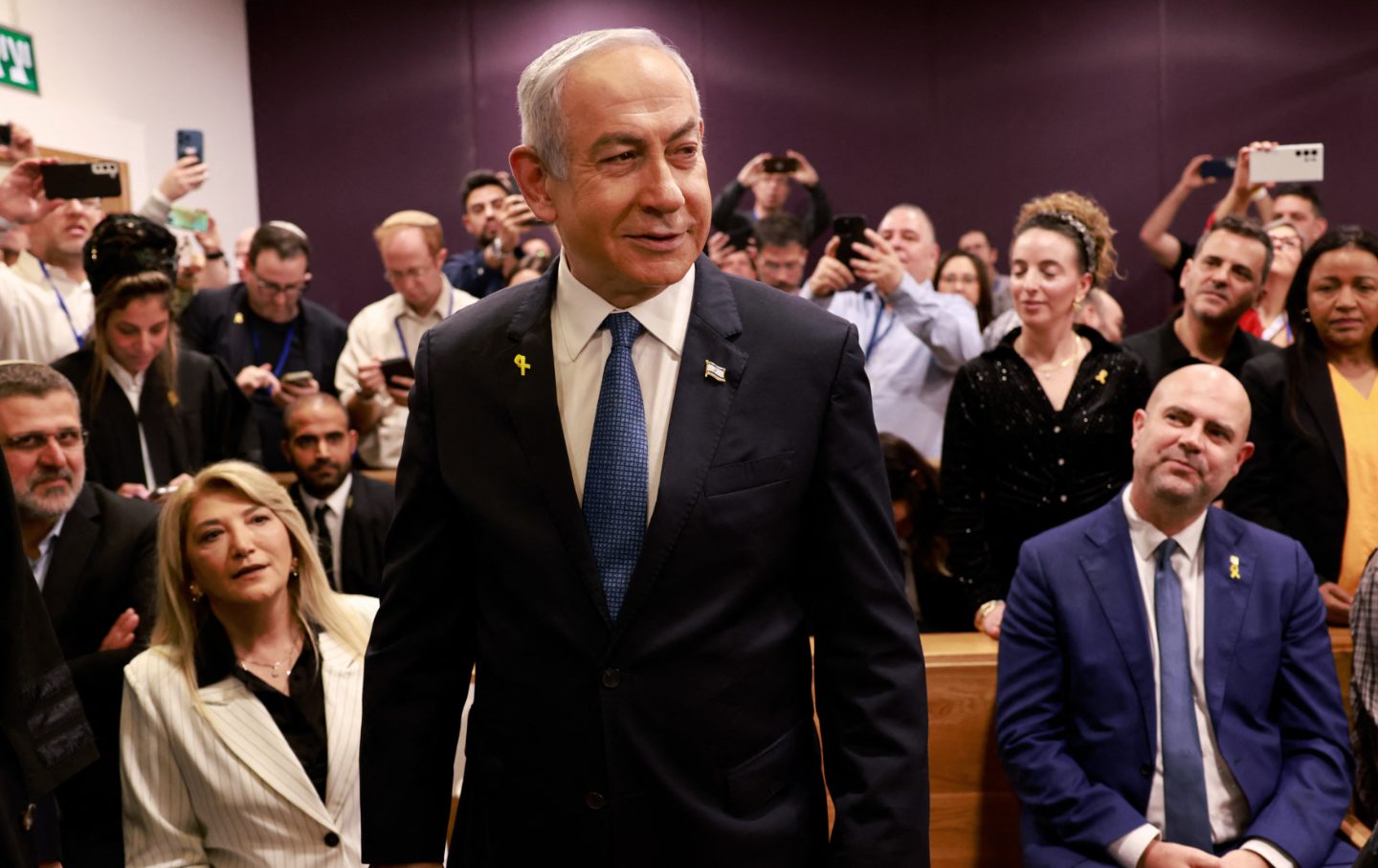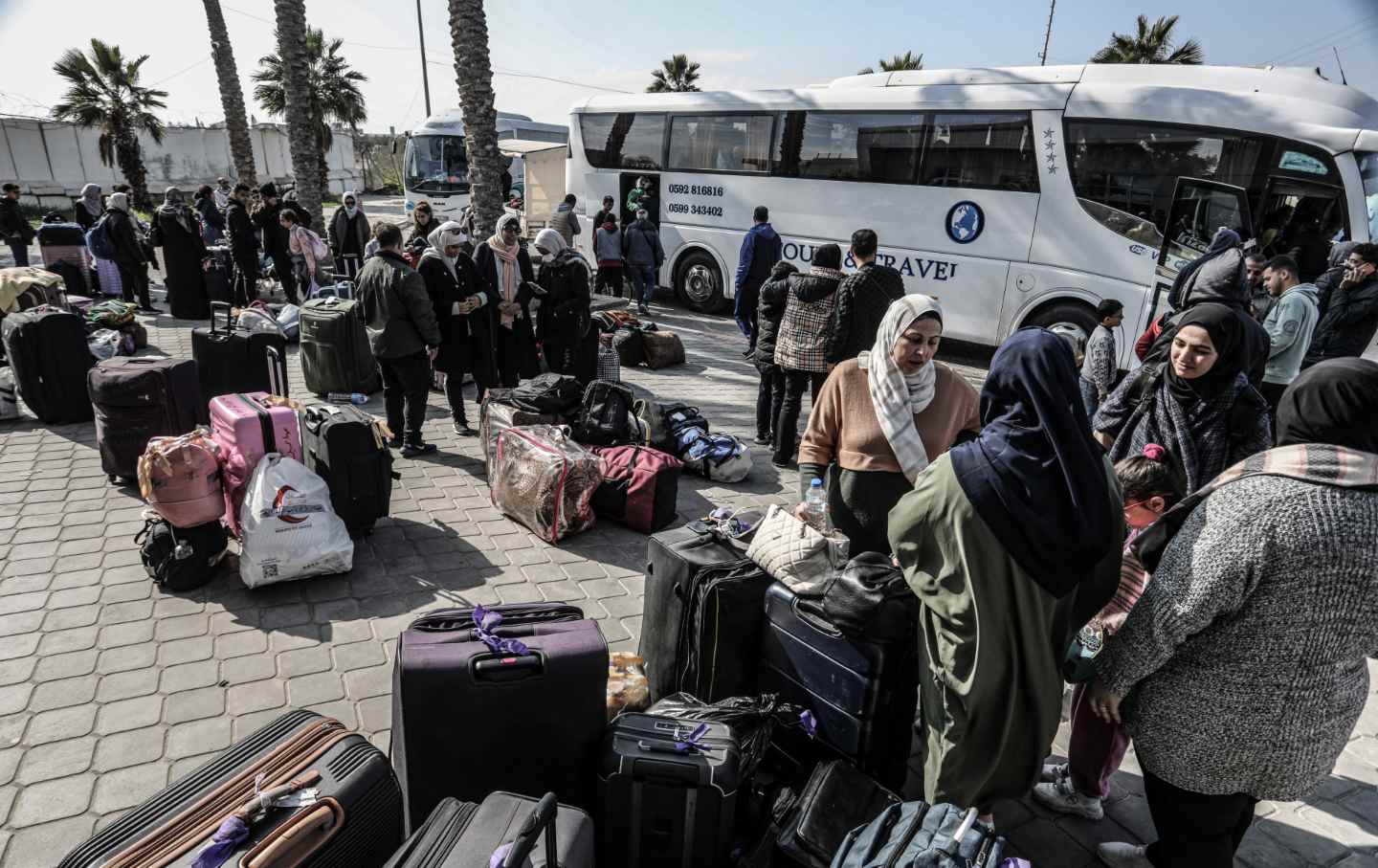The Problem With the US Media’s Coverage of Gaza
Assuming there are only two sides to every story misses the reality that most stories have many sides.

An Israeli soldier walks past a destroyed house in Kibbutz Be’eri, near the border with Gaza, on October 11, 2023.
(Menahem Kahana / Getty)This article originally appeared at TomDispatch.com. To stay on top of important articles like these, sign up to receive the latest updates from TomDispatch.com.
What a world! For eight weeks now, events in Israel and Gaza have been the story of the hour, day, week. And what exactly are we to make of that?
Let’s start with the obvious: American media coverage of the horrors there has been nonstop since the Hamas slaughter of October 7. In fact, it’s knocked Russia’s war in Ukraine, the one we were told was so essential to the future of democracy, off front pages (and their media equivalents) everywhere. And the coverage of recent protests has strikingly outpaced those of any other anti-war protests in this century. What the American news media do is, of course, only part of any story, but their recent protest focus contrasts vividly with how they’ve typically covered anti-war and peace actions and so reveals something about how we Americans are thinking about war and peace right now.
When Russia invaded Ukraine in February 2022, American journalists did report on the outrage over that country’s actions and the outpouring of support for Ukraine, but in the endless months of conflict since then, they’ve paid almost no attention to actions calling for a negotiated settlement there, even as that war goes bloodily on and on. Neither was there much coverage of anti-war protests against Washington’s endless conflicts in Iraq and Afghanistan after February 15, 2003, when (depending on whom you read) six to 15 million people took to the streets of 600 to 800 cities around the world in the largest one-day anti-war protest in history. There, too, even though anti-war veterans and peace groups continued to stage actions, the interest of American news outlets soon evaporated.
Admittedly, Camp Casey, a sprawling encampment of relatives and supporters of soldiers and veterans who wanted to stop the war in Iraq, which sprang up near a vacationing President George W. Bush in August 2005, temporarily caught the attention of a bored press corps idling in the heat. By spring 2008, however, when I was trying to drum up interest in Winter Soldier: Iraq and Afghanistan, a sizeable gathering of Americans who had fought in those two wars and were publicly testifying about their misguided actions there, I was dismissively told by a New York Times reporter, “If you read The New York Times, you would know that it doesn’t cover rallies.”
A couple of summers ago, The Boston Globe and other local news outlets showed no interest in talking to anyone boarding buses in that city for the Poor People’s Campaign’s Moral March on Washington, which included antimilitarism in its platform. In contrast, when about 100 locals boarded buses for a pro-Israel rally in Washington this November, the Globe devoted 24 paragraphs to the story. (Granted, the pro-Israel-march buses loaded at Gillette Stadium, home to the Patriots football team, which is always news in these parts.) It’s common to gripe about insufficient reporting on a cause you care about, but for me—and I’ve covered anti-war actions since 2001—it’s striking that the media, in their gatekeeper and agenda-setting roles, have been so eager to cover protests about Israel’s war in Gaza in ways they seldom did when it came to US anti-war actions earlier in the century.
Does it matter if you throw a protest march and reporters don’t come? Yes, because the very point is to be noticed. The news media are a sphere where competing ideologies and aims play out in the open. So, the way marches and other actions are or aren’t covered helps shape public opinion, affirms or challenges received wisdom, creates a historical record, and—fingers crossed—helps define future political practices.
In this case, with the United States in a powerful position to influence the course of the war on Gaza, continued reporting on anti-war protests could help pressure President Biden to stop embracing (could there have been a worse optic?) Israeli Prime Minister Benjamin Netanyahu and demand a permanent cease-fire instead.
Why This Story Now?
Amid competing narratives, unverifiable information, intense emotions, and everything we still don’t know, it’s important to keep all the often-contradictory realities we do know in mind—and be suitably alarmed.
We know that the United States lavishes at least $3.8 billion yearly in military aid to Israel, along with Get Out of Jail Free cards when it comes to human-rights abuses. Josh Paul, a State Department official who resigned in protest over the way our weaponry was killing Gazans, reminded us of just that recently. (The United States has also given money to the Palestinian Authority Security Forces, but vastly less of it.)
We also know that 1,200 Israelis were slaughtered in the October 7th raids by the armed wing of Hamas, the most Jews killed at one time in that country’s history. And we know that about 240 others of all ages were kidnapped in those raids and held hostage.
We know that nearly 16,000 Palestinian civilians have now been killed in Israel’s ongoing war in Gaza and that about 1.7 million Gazans, three-quarters of the population there, have been forced to flee their homes in search of ever more elusive safety. We know that, of about 2,000 Palestinians held in Israeli prisons without charge or trial, 240 were released in exchange for 105 Israeli hostages and that, in the same period, about 244 Palestinians and four Israelis were killed in clashes on the West Bank.
We’ve gotten little information on combatant casualties in Gaza, save occasional announcements from the Israeli military and a rare statement from Hamas, but that’s not unusual. In recent American wars, only independent organizations like icasualties and the Costs of War Project have tried to offer comprehensive reckonings of the damage done.
“Far too many” Palestinians have been killed, said Secretary of State Antony Blinken in early November, but how many is the right number when civilian deaths of any sort should be unacceptable? In the face of so much slaughter, destruction, and upheaval, the urge to choose sides, take a stand, make a statement, or man the barricades was compelling. And so it was hardly surprising, after the barbarity of October 7, that rallies in sympathy with the Israeli hostages, against antisemitism, and even calling for revenge sprang up around the world. As many as 290,000 protestors gathered in solidarity with Israel on the National Mall in Washington, D.C., on November 14. But as the Israeli assault on Gaza escalated and civilian deaths soared, sympathies began to shift and protests here and elsewhere calling for a cease-fire and an end to the occupation of Gaza grew rapidly.
Meanwhile, staff and political appointees at the State Department, the US Agency for International Development, and at least 40 other government agencies signed letters or memos calling for a cease-fire, as did at least 100 congressional staff members, who staged a walkout. People put up posters of Israeli hostages. Others tore them down. Businesses and institutions issued position papers and those that didn’t were pressured to do so. Even restaurants got into the act.
On university campuses, those sympathizing with various positions sprang into action and began to duke it out. Students for Justice in Palestine was kicked off certain campuses; some student protesters were vilified and doxxed, even losing future job offers; and alumni weighed in, threatening to withhold donations. All of this was heavily covered by news outlets, which thrive on stories about extreme positions staked out early, along with in-your-face actions, heavy-handed responses, the selective suppression of speech, and the influence of money on all of that.
Popular
“swipe left below to view more authors”Swipe →So, obviously one explanation for the coverage is that the protests, marches, demonstrations, rallies, and disputes have been too big, widespread, and persistent to ignore, but it’s not that simple. (It never is, is it?)
We in the United States are, in some sense, close enough to the war in Gaza to make protest a reasonable response—thanks to the military funding provided to Israel, the historical relationship between the two countries, blood ties and friendships between many Americans and Israelis and/or Palestinians, and vivid parallels between the mistreatment of people of color in the US and of Palestinians in Israel, Gaza, and on the West Bank. Yet the US is also nearly 7,000 miles away and none of our own military is (at least as yet) on the ground there. Even with alarming upsurges in antisemitism and Islamophobia, life in America is, for most of us, still comparatively safe. So is most political action.
Over the past decade or so, we’ve also become increasingly accustomed to such concerted political actions—Occupy Wall Street, Black Lives Matter, March for Our Lives, student walkouts for climate change, and picket lines for industrial strikes (often led by young activists). And despite the difficulties and dangers of reporting from Gaza—at least 63 journalists and media workers have been killed in the war so far—an established press corps in Israel and surrounding countries has made both the nightmare of the October 7 attacks and the increasingly horrific war conditions in Gaza all too vivid to Americans.
Inside/Outside the Frame
There’s a journalistic adage that goes: If your mother says she loves you, check it out. A corollary might be: If your mother says you’re perfect, consider the source. Good journalism, in other words, involves constant verification and an instinct for skepticism.
But journalism isn’t stenography and journalists tip their hands all the time. They make choices about what’s news and how to frame it; what to include, emphasize, or omit; who gets quoted and who’s considered a reliable source or expert. It’s clearly their job to inform us as fully, honestly, and fairly as possible so we can make our own moral decisions, including about whether and what to protest.
“The only way to tell this story is to tell it truthfully,” wrote David Remnick, editor of The New Yorker, as he began his multifaceted report on a trip to Israel shortly after October 7, “and to know that you will fail.” You can watch journalists trying to get it right—the protests, the war, the horrors, the consequences—to do justice to the story and the people at its heart. And yet they fail for many reasons. (How could they not?)
Sometimes, it’s the pressure of social media and the 24/7 news cycle, which promotes a rush to publish before necessary information is in. Sometimes, it’s because the topic is complex and requires a backstory and context most Americans (even journalists) don’t already know. Worse yet, it’s hard to fit such complexity into short paragraphs, concise lead sentences, and even more concise headlines, which are often all the news that its consumers have the time to take in.
Sometimes it’s that word-packages—displaced, surgical strikes, humanitarian crisis—become so routine we essentially stop noticing. The camera, too, can be an aid or a weapon, and even grammar comes into play, as in the difference between Israeli civilians were killed (by stated or implied actors), while Palestinians civilians died, as if by some unknown force or their folly in being in the wrong place at the wrong time.
I’ve been hung up lately on the word horrors and its variations: horrible, horrific, horrifying. Examples of their use in such media coverage are legion. The writer in me wants to come up with a fresh word that would really allow us to absorb and truly consider the—yes!—horrors of what’s now happening in Gaza. Then I recall these two lines from Pablo Neruda’s searing poem about the Spanish civil war:
and the blood of children ran through the streets
without fuss, like children’s blood.
This war, like all war, is indeed horrible.
Sometimes the coverage problem is what’s pejoratively called bothsideism or, more generously, balance. But assuming there are only two sides to every story misses the reality that most stories have many sides. The protesters in recent demonstrations, for instance, embraced a remarkable range of demands, intentions, and sympathies, but reporting was so much easier if positions were clear-cut and uniform. So, coverage has tended toward a Manichaean view of the hostilities and those demonstrating about them: pro or con, allies or enemies, Zionist or antisemite, good for America and Joe Biden or a blow to democracy everywhere and the Democratic Party in particular. Such a way of reporting, however, closes down so many other possibilities.
This is particularly apparent when political demonstrations against atrocities like those committed in Israel on October 7th and in Gaza (and the West Bank) thereafter are seen mainly as a spectacle in which reporters count the numbers, repeat the slogans, and focus on a random few who supposedly represent the whole. Individual stories may humanize an issue and draw eyes to an article. Such reporting, however, can also play into a particularly American version of dissent in which the individual resister becomes the story, not the resistance movement. Such a skew can make political protests seem more like a series of individual temper tantrums, at best tolerable outlets for sometimes justified anger, and not much more.
What doesn’t make it inside such a news-media framework is revealing. In this country, as an issue, peace itself has been ceded to the left, which effectively means banished. But imagine, for a moment, what a different world we might be in if our news platforms were to set up peace beats alongside their war beats. What if the opinions of peace workers were as routinely sought out as retired generals and politicians in the pockets of arms manufacturers? What if it was considered a crucial part of the news to explore the complexities of, possible conditions for, and likelihood of peace, rather than presenting it as just the absence of war or a zero-sum game? What if our reporting explored moral issues along with economic and political ones and maybe even figured out how to make peace seem as exciting and newsworthy as war?
I’m not so naïve as to think that a shift in the business of news coverage here in America would end years of animosity and violence in the Middle East. Still, over time it could reorient our thinking about militarism and, given this embattled and battered planet of ours, that doesn’t seem—to me, as least—like such a bad idea.
More from The Nation

Celebrations in Syria May Be Premature Celebrations in Syria May Be Premature
The speed of the Assad dictatorship's collapse stunned even the opposition. But the result is a power vacuum that Israel and Turkey have already moved to occupy.

The Fall of Syria Changes Everything The Fall of Syria Changes Everything
Retired diplomat Chas Freeman and writer Pascal Lottaz discuss what happens now that Damascus is in the hands of Hayat Tahrir al-Sham.

Netanyahu Must Be Brought to Justice. But We Can’t Stop There. Netanyahu Must Be Brought to Justice. But We Can’t Stop There.
This genocide is a massive criminal undertaking, and we must hold as many of its perpetrators accountable as we can.

My Brother, Chef Mahmoud Almadhoun, Died Because He Fed Gaza’s Starving Citizens My Brother, Chef Mahmoud Almadhoun, Died Because He Fed Gaza’s Starving Citizens
His killing by Israel sent a chilling message that no one is safe, including humanitarians who stand in the way of Gaza’s erasure.

The Underground Network Helping Gazan Refugees Survive in Egypt The Underground Network Helping Gazan Refugees Survive in Egypt
A patchwork of volunteer-run mutual aid organizations has sprung up to tackle the severe problems facing people fleeing genocide.

The Dangers of Trump’s Foreign Policy The Dangers of Trump’s Foreign Policy
Strategic incoherence and factionalism reign.


